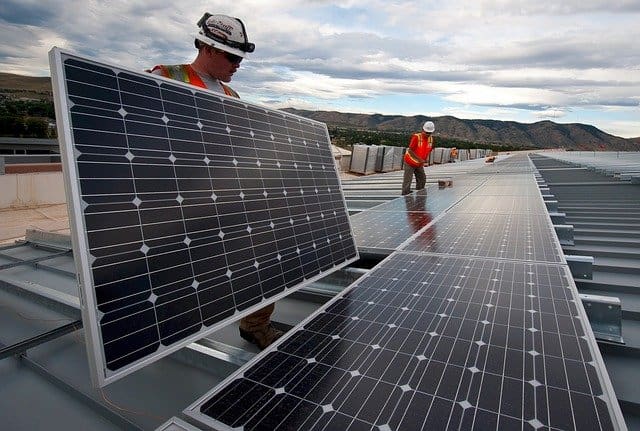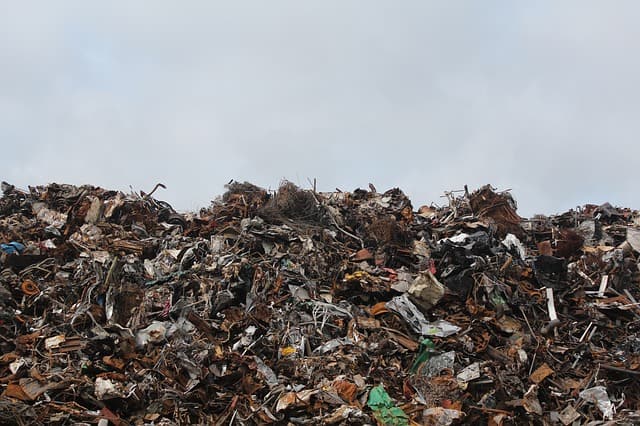Before discussing when solar panels work best, let’s understand what is a solar panel.
A solar panel is made by putting together a huge number of cells and connecting them electrically. Afterwards, these cells are then fixed into a support frame in a grid-like pattern in the assembly of 6×10 solar cells. They should be fixed on the upper part of the frames.
The cells are majorly photovoltaic which can be used to produce power through the photovoltaic effect. Photovoltaic in simple idThey generates electricity flow by allowing light photons to hit the free electrons from atoms.
A conclusion can be drawn to state that solar panels generally operate by trapping sunlight and convert it into different forms of energy either light energy or heat energy.
In this case, the maximum solar energy generated depends on the amount of solar radiation being received on earth at a particular time. The sun’s radiation changes throughout the day and seasons in a year the same as the strength and angle of sun received. This affects the quantity of energy a solar power system can produce.
Let’s see what is solar energy.
What Is Solar Energy?
The sun is the source of solar energy. Solar energy is acquired by tapping heat and light that has is produced by the sun. Each day dawn, the sun emits a huge quantity of energy.
The solar releases more energy in one second than humans have ever used since the beginning of time. Sun is like other stars just but it is a bigger ball compared to the rest. This gas ball is usually made up of hydrogen and helium gases.
Through the process of nuclear fusion, the sun releases energy at its core. Throughout the nuclear fusion process, the sun’s exceeding high pressure causes separation of the hydrogen atoms leaving their central cores to integrate.
One helium atom is formed by a combination of four hydrogen nuclei, but one helium atom weighs less compared to the four hydrogen atoms that fused to form it because some matter is lost during the nuclear fusion process.
At this point, the lost substance is from the disintegrated hydrogen atoms is released into space as radiant energy. Therefore, solar energy can be defined as the conversion of light energy that is radiated from the sun to electricity.
With all the energy radiated from the sun, only a small portion of it strikes the earth. However, daily the quantity of energy reaching the earth is vast.it is usually more than enough to supply the earth with energy for more than one and a half years.
Now, let’s discuss when solar panels work best…
Which Timings Do Solar Panels Work Best?
As long as you’ve got had your solar panels placed at an appropriate angle and facing the proper approach, you’ll truly expect the optimum time for energy production to be the morning.
Though this may ultimately rely on various factors, and therefore, the morning result will solely last for several hours.
Throughout the middle part of the day, you’ll additionally expect a small increase in the quantity of energy being made. However, in terms of the energy being made by star panels, it’s additional concerning the additive build-up of energy and not specific peaks throughout the day.
The enhanced brightness of the sunshine can cause additional energy being made, with optimum, energy-producing clear light-weight being common throughout the first hours.
The best star generation throughout the day is typically from 11 am to 4 pm. However, a day has about 3 hours which are normally known as peak hours.
Which Days Do Solar Panels Work Best?
Weather conditions are not constant as they vary across the year. The weather conditions might be sunny, cloudy, or rainy. Solar panels are made using a photovoltaic technology that can work in cloudy and rainy seasons by trapping the available solar radiation from the sun.
However, solar panels work most effectively during sunny days. This is due to the increased brightness of sunlight leading to high production. Despite that solar panels flourish in hot, sunny weather, a lot of heat can alter their functionality hence affecting the general output.
How does excessive heat affect solar panels? In an event where it is extremely hot, solar panels get heated and when they get heated to temperature surpassing 25°C the power output begins to reduce. This is indicated in the description tag by manufactures.
There is a myth where people think that solar only works on sunny days which is not true. For solar panels to generate e energy it does not need constant sunshine.
This means they can work during cloudy and rainy days. Solar panels fitted on the roof also work on indirect light. Therefore, solar panels generate electricity when it is cloudy and rainy outside.
These panels can still yield about 10% – 25% of their optimum output on a cloudy day. this quantity is much less than energy produced during periods of direct sunlight but does not mean that they produce nothing.
The intensity of the unfavourable weather will affect the exact energy produced considering how heavy the rains are, and darkness caused by cloud coverage in the sky. This affects the amount of solar radiation penetrating to the earth.
The good thing to note is that rain positively helps your solar panels to function more proficiently after the storm since the showers clean away all the dirt, dust and pollen stuck on them.
Which Seasons Do Solar Panels Work Best?
A year has different climatic seasons with the two major ones being summer and winter. Different areas across the world experience these seasons at different times due to the round nature of the earth which creates a difference in which the sun radiations travel to reach the earth.
Throughout the year, there is sunshine including winter times and as stated earlier solar power generation is more about light radiated from the sun.
The major factor that creates a difference among the seasons is the length of the days. Summer seasons experience longer daylight hours while winter seasons have few hours of sunlight radiation being experienced. The highest power production will generally be during summer when day hours are longer.
Despite minimal hours of sunlight experienced in winter months, solar panels will still operate but will produce little energy. This can conclude that in the same area, solar systems can produce double the electricity in summer, then in the short days of winter.
The closer the earth is to the sun, the more solar energy produced, this experience in the summer for the southern hemisphere and the winter for the northern hemisphere. For example, the sun is normally overhead in the summer for the US making it generate more energy during that period.
In What Places Do Solar Panels Work Best?
As highlighted in the previous section, the planet earth is round-shaped. This, therefore, the sun hits the earth’s surface at different angles. When the sun is right above, its rays strike direct and travels a shorter distance to the earth’s surface giving it maximum energy.
In cases where the sun rays are slanted, they get scattered and also travel a longer distance.
The distribution of solar radiation across the world is not even as it fluctuates in intensity from one geographic area to another. This difference is due to the change of latitude, season, and time of day. There has been a growing need to classify areas with promising conditions for solar energy development.
Generally, it has been proven that the geographical dissemination of total solar radiation is divided in terms of intensity into four broad sun belts around the world.
The regions located between 15°N and 35°N has been found to have the highest natural solar energy potential. The regions include the Middle East and the North African region; the rest are from Asia and the Pacific, Latin America and Sub-Saharan Africa. This is because these areas are located within the equator line where the sun is close to the earth and it hits the surface vertically.
These regions also experienced two summer seasons in a year. They are generally characterized by their semi-arid climate and therefore have little cloud cover and minimal rainfall in a year with approximately 3,000 hours of sunshine per year.
These regions are mostly among developing countries. They can take advantage of the sunlight to be the main source of energy since it is readily available and cheaply exploited. This energy can be used for both rural and urban needs.
The Best Conditions For Solar Panels
No one is capable of controlling the natural occurrences of weather and climatic conditions. There are other major things which we can put inconsideration to maximize the optimum performance of solar panels which include;
- Installing solar panels facing the southern direction: The direction in which you install your solar system is among the most important factors which should be considered. If you are advantaged to have a section of your roof that is facing the southern direction, it is the best spot to fit your solar panels. The south direction help in ensuring maximum trapping of sunlight through the day considering the sun rises in the east and sets in the west.
- Install them inclined at an angle which the sun hits perpendicularly: Solar panels generate energy at the maximum rate when sun radiation hits them directly and at a right angle. This, therefore, you will need your panels set so as sunlight hits them directly as possible. Giving an example of the UK, the ideal angle is between 300 and 400. However, to the revolving of the earth, the sun changes its position throughout the year. For optimum energy production in the winter, panels should be placed at a sharp 600 while during the summer an angle of 200 is the best. Since it is not possible to keep on readjusting the panels once they are installed that is the reason a permanent position of 300 is commended.
- Remove any object causing shade: Solar panels should be placed in open fields or on rooftops. This is to give them total exposure to sun radiation. Any physical obstacles which could cast a shadow or shade on the panels should be cleared that is cutting of big trees around or reexamine a better place.
- Keep your panels clean: After the installation of your solar panels, dust, dirt, and pollen accumulate on them with time. This degrades the power production of the panels, hence, progressively make them less operative. This happens because the sunlight will not be able to get to the solar cells under the grime easily. This results in decreased solar power produced and which will inconvenience the needs, it is needed because it can’t meet its consumption demand. Rainfall help in cleaning the solar panels but it is not enough since it is not thorough. According to manufactures guiding instructions, you should at least wash your panels once or twice a year.
The life Expectancy Of Solar Panels
The majority of residential solar panels usually have a warranty of 25 years, but there are made to function for about forty to fifty years. The advantage of solar panels is that they do not have moving parts, hence, the chances of something getting damaged or breaking is very minimal. This makes its maintenance costs almost close to zero.
Conclusion
The functionality of solar panels is clearly seen to be affected by a number of factors which occur naturally. Despite these factors, generally, solar panels generate energy throughout the just that the amount varies. It can only fail to produce energy during extreme unpleasant weather whereby there is not sunlight being experienced or its production has degraded to the extreme levels to cause total dysfunction.
In areas with a high potential of solar energy, it should be exploited to maximum levels. It will help in environmental conservation and cutting down of other power generation cost.





Hi! I hope you wouldn’t mind if I show this article to my sister before she orders an installation in the near future. You see, she plans to get a couple of solar panels for her kitchen since the area constantly receives sunlight during the day. Shout out to you for reminding us to clean our panels frequently to preserve their effectiveness.